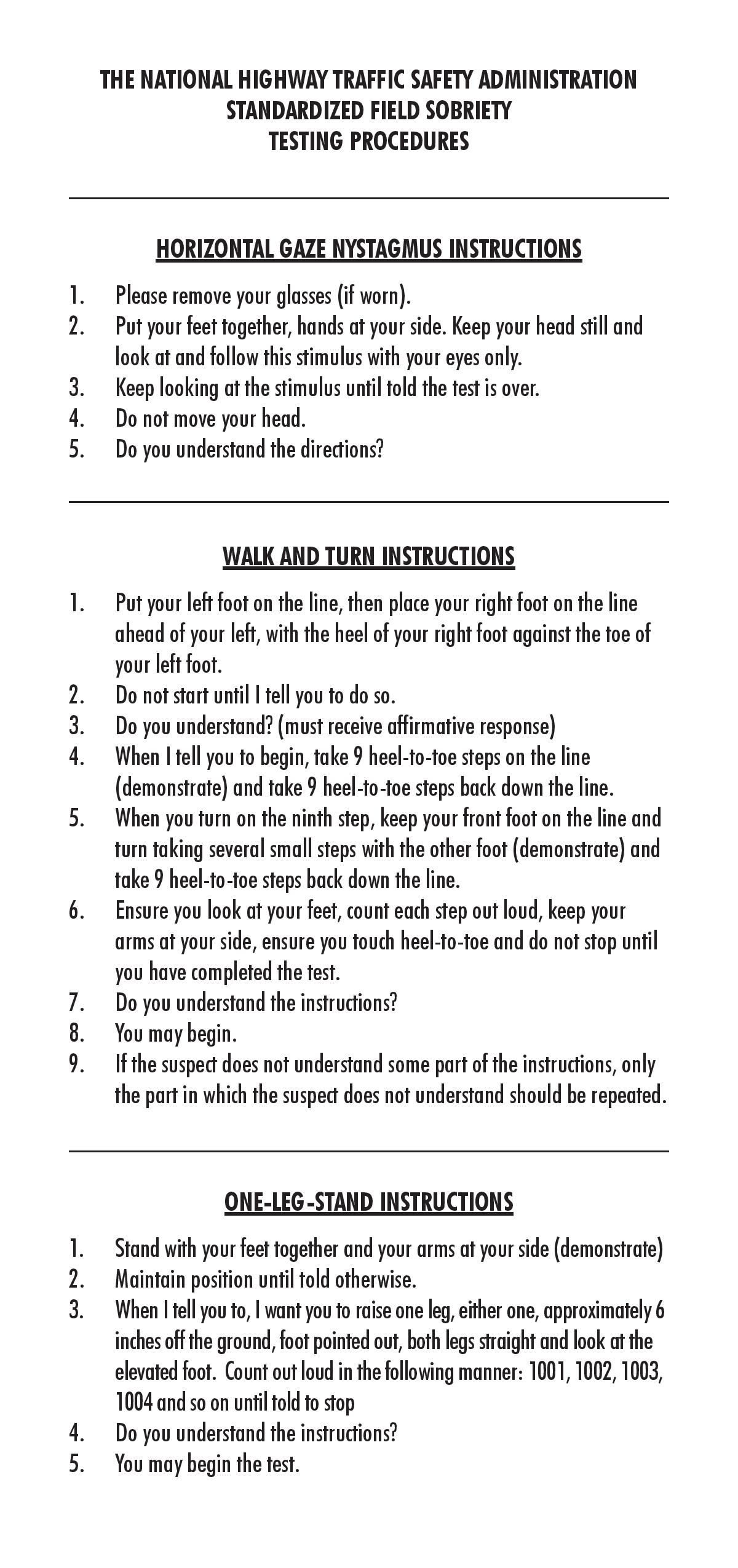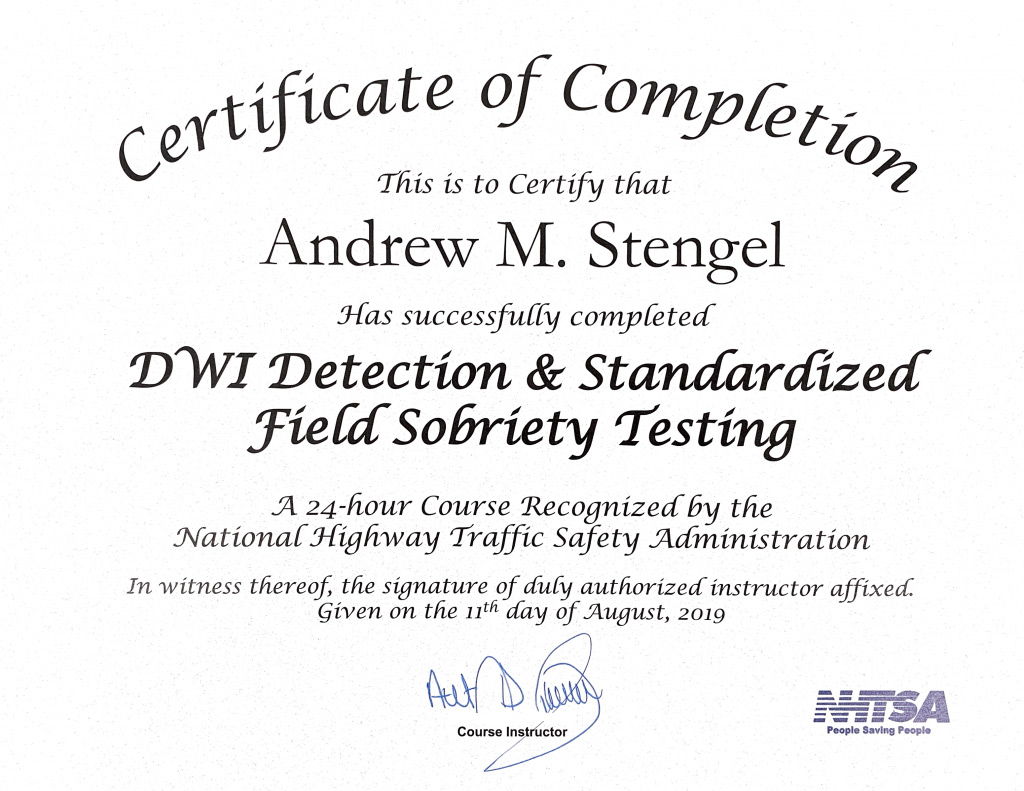DWI Field Sobriety Tests in New York: Standardized Tests
 In the 1970s the National Highway Traffic Safety Administration (NHTSA) funded a series of studies to create a series of tests to determine if a person is intoxicated. These tests, which are used in Driving While Intoxicated (DWI) stops throughout the country, are known as Standardized Field Sobriety Tests (SFSTs). Police are required to undergo 24 hours of training before being certified to perform SFSTs during stops for suspicion of DWI.
In the 1970s the National Highway Traffic Safety Administration (NHTSA) funded a series of studies to create a series of tests to determine if a person is intoxicated. These tests, which are used in Driving While Intoxicated (DWI) stops throughout the country, are known as Standardized Field Sobriety Tests (SFSTs). Police are required to undergo 24 hours of training before being certified to perform SFSTs during stops for suspicion of DWI.

Andrew M. Stengel is trained the same way as police to perform DWI Standardized Field Sobriety Tests.
The SFST is really three separate tests: horizontal gaze nystagmus, walk and turn and one-leg stand tests. Police outside of New York most often employ SFSTs. In New York City the police often use what are known as coordination tests during DWI stops, which also involve three separate tests: walk and turn, one-leg stand and finger to nose tests. Even though two of the three tests overlap with SFSTs, the majority of the New York City Police Department (NYPD) does not receive the required training to administer SFSTs. The few police officers in the NYPD who have received SFST training will perform horizontal gaze nystagmus on a person who is stopped for DWI. Whether the test for DWI is the NYPD’s coordination test or the Standardized Field Sobriety Test, the results are highly subjective and subject to attack by an experienced DWI defense attorney. Each of the SFSTs has a set of specific instructions and clues that may indicate that a person is intoxicated.
Horizontal Gaze Nystagmus DWI Field Sobriety Test
Horizontal Gaze Nystagmus (HGN) is called the most reliable DWI field sobriety test by the NHTSA. It’s also the only field sobriety test that is only visible to the police officer who performs the test. That’s because the test involves the observation of a person’s eye.
Nystagmus is known as the involuntary jerking of one’s eye, which may increase due to alcohol concentration in one’s blood. The four parts of the horizontal gaze nystagmus test which are performed on both eyes, are: smooth pursuit, maximum deviation, prior to 45 degrees and vertical nystagmus. The horizontal gaze nystagmus DWI tests are performed with a stimulus, which is usually a finger or a pen, at a distance of about 12 inches from a person’s nose.
When police perform the SFTS for horizontal gaze nystagmus the following instructions are given:
- Please remove your glasses (if any)
- Put your feet together, hands at your side
- Keep your head still and look at and follow this stimulus with your eyes only
- Keep looking at the stimulus until told the test is over
- Do not move your head
- Do you understand the directions?
Even before performing the test police are required to confirm that equal tracking and equal pupil size in both of a person’s eyes. Police are trained to move the stimulus rapidly from the center of a person’s eye to the far left, to the far right and then back to the center. When looking for equal tracking police are looking for equal pupil size and obvious neurological symptoms (even a police officer has not received medical training).
The first horizontal gaze nystagmus tests is called smooth pursuit. Police will twice move the stimulus from the center of a person’s eye to the far left and back to the center, followed by far right and back to center. The stimulus is required to be moved at a speed of at least two seconds from the center to the side and then at least two seconds back to the center. If the police claim that an eye jerked, i.e., there was not smooth pursuit, they will mark the test as a clue of intoxication.
Next, maximum deviation test involves moving the stimulus to one side and held at that position to determine distinct nystagmus. The idea of distinct nystagmus is somewhat confusing because even sober people will exhibit some form of nystagmus that is visible. In performing the test a police officer will move the stimulus from the center to one side at a rate of at least two seconds. The stimulus will be held for at least four seconds at maximum deviation and then moved back to the center at a rate that is greater than two seconds. This is done for each eye. Police will mark a clue as distinct and sustained nystagmus at maximum deviation for both eyes.
Next, the prior to 45 degrees test requires police to move the stimulus slowly from directly in front of a person’s nose to a person’s shoulder at a rate of least 4 seconds to reach a person’s shoulder. Police are required to record the angle at which nystagmus is observed and repeat the test twice for each eye. If nystagmus is observed prior to 45 degrees police will mark it as clue for DWI.
Finally, the test for vertical gaze nystagmus is administered by raising the stimulus until a person’s eyes are elevated as far as possible for 4 seconds. Any jerking of a person’s eye will result in a positive clue for DWI.
There are a total of 3 clues per eye, in addition to a single clue for vertical gaze nystagmus. Based on NHTSB research, if 4 or more clues are observed it is likely that a person’s BAC is at least .08%. Most people call .08% the legal limit, but it is actually the illegal floor for DWI in New York. A person who has .08% BAC (or greater) may be charged with DWI in New York Like all of the SFSTs involved in DWI stops, the horizontal gaze nystagmus test is highly subjective—and the results are only visible to the police.
Walk and Turn DWI Field Sobriety Test
 The DWI walk and turn SFST involves 9 heel-to-tie steps in one direction and then back. When police perform the walk and turn test the following instructions are given:
The DWI walk and turn SFST involves 9 heel-to-tie steps in one direction and then back. When police perform the walk and turn test the following instructions are given:
- Put your left foot on the line, then place your right foot on the line ahead of your left, with the heel of your right foot against the toe of your left foot
- Do not start until I tell you to do so
- Do you understand?
- When I tell you to begin, take 9 heel-to-toe steps on the line (which are demonstrated) and take 9 heel-to-toe steps back down the line.
- When you turn on the ninth step, keep your front foot on the line and turn taking several small steps with the other foot (which are demonstrated) and take 9 heel-to-toe steps back down the line
- Ensure you look at your feet, count each step out loud, keep your arms at your side, ensure you touch heel-to-toe and do not stop until you have completed the test
- Do you understand the instructions?
If a person indicates that they understand the instructions, then the test will begin. Any instructions that were not understood will be repeated. The following 8 clues are observed for signs of DWI
- Can’t keep balance during instructions
- Starts too soon
- Stops walking
- Misses heel-to-toe
- Steps off line
- Uses arms for balance
- Improper turn
- Incorrect number of steps
According to NTSB research, 2 or more clues indicate that a person’s BAC is .08% or above. As noted above, that is considered per se DWI in New York. If a person has never performed the test before—and why would somebody have unless they were previously stopped for DWI?—then 2 clues in an absurdly low number. In fact, a person who is completely sober might exhibit a majority of the clues—because they are being asked to perform a test on demand when they never heard the instructions or practiced it before.
One-Leg Stand DWI Field Sobriety Test
The final STFT for DWI involves standing on one leg with the other leg lifted slightly off the ground. Police give the following instructions to people performing the one-leg stand test:
- Stand with your feet together and your arms at your side (which is demonstrated)
- Maintain position until told otherwise
- When I tell you to, I want you to raise one leg, either one, approximately 6 inches off the ground, foot pointed out, both legs straight and look at the elevated foot. Count out loud in the following manner: 1001, 1002, 1003, 1004 and so on until told to stop
- Do you understand the instructions?
Police do not reveal in advance or explain in the instructions that the test is timed for 30 seconds. Police record the following 4 clues as signs of DWI:
- Sways while balancing
- Uses arms to balance
- Hopping
- Puts foot down
According the NTSB research, if a person demonstrates 2 more clues or cannot stand on one leg for 30 seconds it is likely they are intoxicated under New York law. Like the walk and turn test, even a sober person may find it difficult to balance on one leg for 30 seconds.
To Perform or Not Perform SFSTs During a DWI Stop
Whether the test performed during a DWI stop involves standardized tests or the NYPD’s coordination tests, an experienced DWI defense attorney can attack the results. In New York, unlike the request to take a chemical test, which is usually a breathalyzer, does not legal consequences.
Refusing to take a breathalyzer results in the automatic revocation of a person’s license to drive, in addition to other civil penalties, and the refusal can be used at trial as consciousness of guilt. On the other hand, refusing to perform SFSTs or coordination tests only means that the evidence cannot be used at trial. If a person refuses SFSTs and would have done well, a prosecutor and/or jury will never know. If a person refuses SFSTs and would have done poorly, then similarly nobody will ever know. The decision of whether or not to submit to a chemical test and SFSTs or coordination tests is a fact specific question. If a person is stopped for DWI, he or she should try to consult with a defense attorney before deciding.





